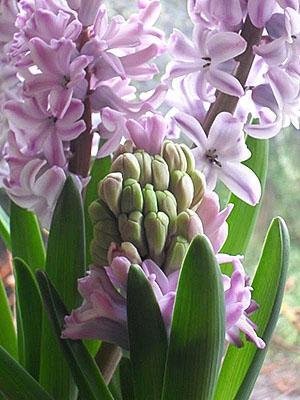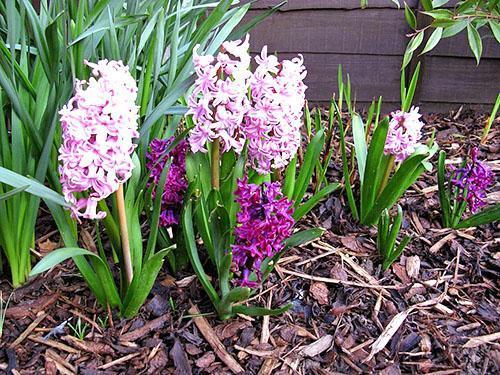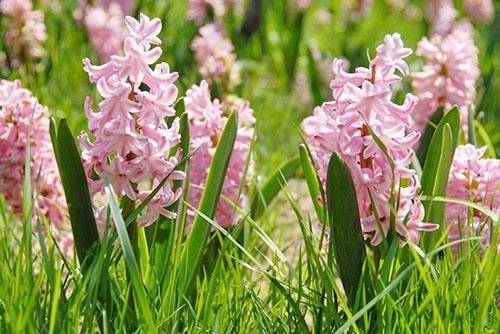Why don't our favorite hyacinths bloom in the garden?
 Even the most unpretentious plants have some characteristics and have their own requirements for planting and care. Agrotechnics used when growing hyacinths in the garden, also due to the need to create comfortable conditions for decorative culture. And here hyacinths manifest themselves as warm-loving beauties that require attention and do not forgive mistakes.
Even the most unpretentious plants have some characteristics and have their own requirements for planting and care. Agrotechnics used when growing hyacinths in the garden, also due to the need to create comfortable conditions for decorative culture. And here hyacinths manifest themselves as warm-loving beauties that require attention and do not forgive mistakes.
Traditionally, expecting abundant flowering of these bulbous plants in April or May, sometimes flower growers in the spring do not observe the desired bright arrows. Why don't hyacinths bloom in the garden? At what stage was the mistake made, and how not to make it again next season? An onion will help to answer these questions and find out the reason why hyacinths do not bloom in the garden. This is the main part of the plant, on the state of which not only flowering depends, but also the growth of hyacinth, its health and reproduction.
Year-round cultivation of hyacinths in the garden

If the bulb left in the ground until the fall was in cool, moist soil, then by winter it not only does not have time to prepare well, but can also be affected by soil pests, pathogenic fungi and bacteria. This means that in the spring, at best, a weak peduncle will appear. Sometimes after a cold rainy summer, flowering is not observed at all.
When the cultivation of hyacinths in the garden is accompanied by their digging in early summer and proper storage until the end of September or October, the risk of not seeing lush fragrant inflorescences is greatly reduced.
The quality of the hyacinth bulbs grown in the garden
 In addition, without digging the bulbs for the summer, it is impossible to control the quality of the planting material. But hyacinths can:
In addition, without digging the bulbs for the summer, it is impossible to control the quality of the planting material. But hyacinths can:
- lack of nutrients;
- experience a lack or excess of moisture;
- be attacked by pests and pathogens of bulbous diseases.
 Aging bulbs also gradually lose their ability to bloom. These features must be taken into account when buying bulbs for growing hyacinths in the garden, and when growing your own planting material.
Aging bulbs also gradually lose their ability to bloom. These features must be taken into account when buying bulbs for growing hyacinths in the garden, and when growing your own planting material.
If during inspection of hyacinths in a store or during storage, soft, mechanically damaged or dried out bulbs are revealed, they should not fall into the ground. Otherwise, in search of a reason why hyacinths have not bloomed, the gardener should only blame himself, as in a situation where bulbs are planted with traces of mold, yellow-brown or gray spots - signs of serious diseases.
Why hyacinths did not bloom: storage errors
 To avoid a situation where hyacinths do not bloom in spring, bulbs dug in June:
To avoid a situation where hyacinths do not bloom in spring, bulbs dug in June:
- washed;
- etched for up to 30 minutes in an insecticide solution;
- dry for a week in a dark, ventilated place at 20 ºC;
- store at 24–26 ºC for 60 days;
- the last month before planting is kept at 17 ºC, making sure that the planting material does not dry out;
- a week before planting in the ground, they are placed at a temperature close to the street temperature in order to harden future plants.
Only healthy processed planting material is stored, which is laid out in one layer either in boxes or in paper bags.
Errors when planting hyacinths and growing them in the garden
 Hyacinths are planted in the soil in September or early October, after pretreating the bulbs with a fungicide.
Hyacinths are planted in the soil in September or early October, after pretreating the bulbs with a fungicide.
- An earlier planting will lead not only to the rooting of the bulb, but also to the growth of the green part, which is fraught with death of the plant from frost or freezing of the flower bud, and then there is no need to wait for spring flowering.
- Planting hyacinths late is also the risk of freezing and one of the reasons why hyacinths do not bloom in the garden in spring.
Since the growing season in hyacinths begins very early, any manipulations with the bulbs in the spring are perceived by plants as extremely painful. Therefore, spring is the time when transplanting hyacinths, as well as planting bulbs in the ground, is highly undesirable. The soreness of acclimatization can be so strong that the plant will refuse to bloom, and the already noticeable arrows will die off.
Sometimes the reason why hyacinths did not bloom lies in the wrong selection of a site for these spectacular plants, as well as insufficient care for a beautifully blooming culture:
- Hyacinths prefer a neutral, well-structured and aerated soil. If the soil is excessively acidic or dense, there is no need to wait for a friendly flowering without additional preparation of the site.
- Lack of glaze during the period of color set, it is also dangerous for the bulbous culture, which can throw off the buds.
- Bulbs weakened by pests and diseases can prevent inflorescences when hyacinths are transplanted to the place of closely related species.
- Thin integumentary scales can be damaged by fresh organic matter used in dressing and when planting bulbs.
- Poor hyacinth flowering awaits the gardener if the plants were planted too often or deeply.
- If the hyacinth gets into dense soil or an area with a lot of weeds, the plant may not have enough strength at all to break through.
 Sometimes a flower arrow dies off, which has already appeared above ground level. The reasons why hyacinth did not bloom in this case are as follows:
Sometimes a flower arrow dies off, which has already appeared above ground level. The reasons why hyacinth did not bloom in this case are as follows:
- the soil is oversaturated with moisture;
- the bulb was planted too early;
- the planting material got into the already frozen ground.
In the middle lane, hyacinth grows well in the open field and annually pleases with rich flowering, but only on condition that all the necessary conditions are created for it, and when leaving, the gardener does not make annoying mistakes.